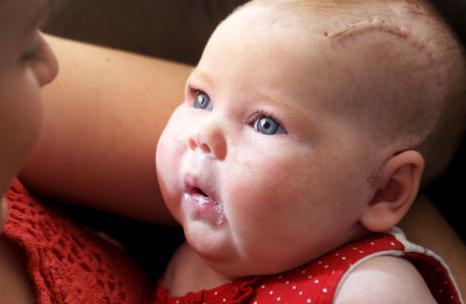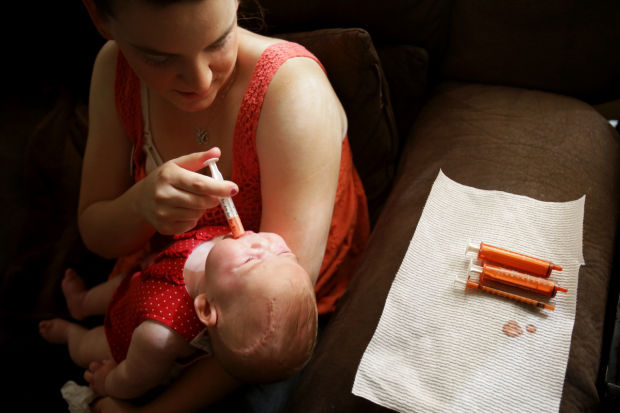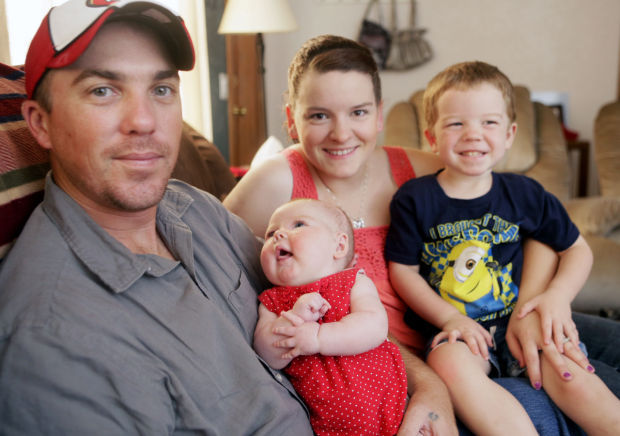Hayden Monroe Poeling seemed healthy when she was born the afternoon of April 8 at Northwest Medical Center.
Her mother, Kimberly Poeling, 28 and dad Keith Poeling, 33, were looking forward to Hayden coming home. So were Keith’s two daughters from his previous marriage, who live with them part time. Hayden’s big brother, Howard, 3, wasn’t quite sure what was happening, but it all seemed exciting.
The family had Hayden’s bassinet and room ready at their rental home in the Picture Rocks area just outside Tucson.
But within hours after she was born, Hayden’s7-pound body began to periodically stiffen, and she’d clench her fists and close her eyes. The nurses said she might just be getting used to being outside the womb.
But Kimberly knew something was wrong. When they went home the day after Hayden’s birth, she began taking videos of the episodes.
And so began the family’s life-changing journey to get help for Hayden. The body stiffening Kimberly had observed turned out to be small seizures that got bigger and increased over time to more than 100 per day.
The Poelings had no experience with the medical system. Kimberly had never been admitted to a hospital for any reason other than birthing her children.
There were a lot of surprises. They learned the importance of doing their own research and advocacy in the face of a serious medical diagnosis. They learned that other parents whose children had the same condition were their most valuable resource. And they learned that Hayden’s best chance at a better life was a risky procedure where half of her brain would be removed or disconnected.
One of their biggest surprises was that Hayden couldn’t get the help she needed in her hometown, so her surgery and follow-up care were done in Phoenix. The family is now considering moving there.
•••
Hayden’s diagnosis came when she was 10 days old: hemimegalencephaly, an extremely rare condition where one side of the brain grows larger than the other. The cause is unknown.
A seizure is like a spark in the brain, similar to an electrical overload. It starts in one area and spreads throughout the brain. Hayden’s seizures started out mild because as a newborn, she had not formed many brain connections. But as her brain started to develop, the seizures changed.
They were imprinting in Hayden’s developing brain much the way the brain of someone learning to play the piano imprints doing scales. Each seizure created new pathways and new connections, and the seizures intensified.
Hayden’s entire body would jerk, sometimes her limbs would move rhythmically. Her blue eyes would open wide. Her lips would purse, she’d scrunch up her face and her whole body would go tense. The seizures happened one after the next, lasting a minute, then two minutes, then longer. One lasted for 20 minutes.
The amount of medication she was getting to calm the brain was preventing normal development, as were the seizures themselves. Kimberly and Keith felt like they didn’t know the real Hayden because of the medicine. She never smiled.
“There are things called critical moments of development that if you miss those or they are not inset well, you are never able to get them back,” said Dr. P. David Adelson, director of the Barrow Neurological Institute at Phoenix Children’s Hospital.
A child needs to learn to recognize faces, sounds, to learn to move.
Hayden was missing out.
•••
Medication didn’t stop the seizures. Kimberly says the neurologists she consulted in Tucson suggested she try more.
She wanted other options. And that maternal instinct was right, Adelson said.
“Once they’ve failed two or three medications, the chance of significant improvement is less than 1 percent,” he said. “This child went quickly through two or three and trying more on her was going to be to the detriment of the child.”
Kimberly says the advice she received in Tucson was to wait until Hayden was older than a year for the surgery. But the more she talked with other parents she met through a Facebook group for parents of children with hemimegalencephaly, the more she became convinced Hayden’s outcome would be better with surgery before her first birthday.
While Tucson has neurosurgeons who operate on children, Hayden’s case required a surgeon with specialized skills for pediatric patients — but no board-certified, fellowship-trained pediatric neurosurgeons practice here. The American Board of Pediatric Neurological Surgery says there are six in the Phoenix area and one in Flagstaff.
The UA Medical Center, Tucson’s only academic medical center, would like to offer pediatric neurosurgery locally in the near future, said Dr. G. Michael Lemole, Jr., chief of the division of neurosurgery at the UA.
It’s not unusual for a midsize city like Tucson to be without a pediatric neurosurgeon, said Dr. Michael D. Partington, chair of the section on neurosurgery for the American Academy of Pediatrics. While the U.S. has 3,000 to 4,000 practicing neurosurgeons, only about 200 are pediatric neurosurgeons, said Partington, a pediatric neurosurgeon at Gillette Children’s Specialty Healthcare in St. Paul, Minnesota. Families often travel to see him from North Dakota and Michigan, he said.
The Children’s Hospital Association has identified pediatric neurosurgeons as a shortage specialty in the U.S. That’s partly because of insufficient graduate medical education money for residencies in children’s hospitals, said Jim Kaufman, vice president of public policy for the D.C-based association. Also, a medical student graduating with $200,000 in student debt might choose an adult specialty over pediatrics because the pay is better, he said.
Children’s hospitals serve primarily patients covered by Medicaid, which on a national level reimburses at a rate that is 30 percent lower than Medicare, Kaufman said.
“Pediatric neurosurgery is one of the concerns we have on Capitol Hill. They talk about the physician workforce and say there are too many specialists, but in pediatrics we don’t have enough,” he said.
Proposed legislation in Congress would improve care coordination for children with complex medical cases by creating a national framework to minimize the need for families like the Poelings to travel and move to find care for their children, Kaufman said.
•••
Kimberly got referrals to two neurosurgeons in the Phoenix area. The first was Adelson, and her appointment with him was July 7. She couldn’t get an appointment with the other neurosurgeon until late August.
Adelson has been in practice for 20 years and has done about 25 hemispherotomies, but usually on children who suffered a stroke. He said has done about six of the surgeries on children with hemimegalencephaly.
Adelson recommended what’s called a cerebral hemispherotomy, where he would disconnect the left hemisphere from the right and from the deep structures, and leave the affected part in Hayden’s skull. That way the abnormal brain would not affect the rest of the body. That surgery is less traumatic than a hemispherectomy, where an entire side of the brain is disconnected and removed.
Hemispherectomies at one time were standard for babies with Hayden’s condition. But leaving the affected brain in the child’s skull is now preferred for a small child, Adelson said. There is a smaller incision, less blood loss during surgery and a decreased chance of hydrocephalus (water on the brain). Infants who get hemispherotomies have better outcomes, he said.
Adelson recommended surgery as soon as possible.
“If we waited until 18 to 24 months of age, the chance of this child having any sort of normal development was going to be unlikely,” he said. “That’s why we recommend surgery at the youngest possible age. The brain is more plastic to be able to make up the differences the younger they are.”
•••
The Poelings both took extended leaves from work to care for Hayden. Kimberly is a special education teacher’s aide in the Marana Unified School District and Keith is a truck driver.
Hayden’s four-and-a-half hour surgery was on Aug. 5, when she was just shy of 16 weeks old. The surgery was risky, but so was doing nothing.
“I feel the chance of her passing away as a result of the surgery was less than passing away as a result of her seizures,” Adelson said. “She could aspirate, get a lung infection, suffer an unexplained death from epilepsy. We felt surgery was a safer option.”
Kimberly and Keith felt the same way.
“She had three hospitalizations before surgery and the first time I saw her hooked up was so traumatic. But I was anxious for her to have no seizures,” Kimberly said.
The most difficult part of the hemispherotomy for Kimberly and Keith was seeing Hayden right after. Her eyes were swollen shut and she had a drain coming out of her head.
•••
In general, the left side of the brain is analytical, the right side creative. But when children have had a hemispherotomy or hemispherectomy, all functions move into the hemisphere that’s working.
“That is the great thing about working with children. They are living miracles,” Adelson said.
When former Congresswoman Gabrielle Giffords was shot Jan. 8, 2011, a bullet went clear through the left side of her brain. As a result of that injury, she lost part of her vision, the right side of her body is partially paralyzed and she has trouble with communication and speech.
Though the entire left side of Hayden’s brain is non-functional, she is already showing more movement on her right side. And her speech may not be affected at all. The difference is the neuroplasticity of a child’s brain.
“This little girl has weakness on the opposite side of her body but because she’s a baby we expect a lot more function than Gabrielle Giffords,” Adelson said. “She’s unlikely to play the piano with that hand but it could still grab things, just not fine movement …She may walk with a little bit of a limp but the leg usually comes back fairly strong.”
Cognitively, Hayden’s future is unclear. Children who have had hemispherotomies often have special needs. But their outcomes vary. Some children have graduated from high school, some graduated college, and they are able to hold down jobs.
Sue Yudovin, a pediatric nurse practitioner at the University of California Los Angeles, has studied the long-term outcomes of children who have had hemispherotomies. She has found that children with Hayden’s condition typically don’t fare as well as children who have the surgery for other reasons. She has also found that children whose left hemispheres were affected have a tougher road than those whose right sides were affected.
“She’ll walk, talk, be potty trained. She’ll have a limp on the right side,” Yudovin said of Hayden. “There is a cognitive hit but it’s hard to tease out exactly what that will be.”
But she said getting Hayden into surgery early means a better chance for a positive developmental outcome. Adelson is optimistic, too.
“If we give intense therapy — speech and occupational — and an enriching environment, these children grow up to be potentially contributing adults,” Adelson said. “Her surgery went well and we are very optimistic for her long-term outcome.”
•••
When Hayden was diagnosed, all Kimberly heard was that the prognosis was poor. She was terrified she’d only have her daughter for a couple of years.
The family is now confident about Hayden’s physical health, and the rest of it is a wait and see.
Some children who have had hemispherotomies need to go back for surgery because not all connections were severed. In those cases, the abnormal part of the brain is removed. Kimberly and Keith hope that’s not the case for Hayden.
They try to enjoy the present. A few days after her surgery, Hayden smiled for the first time. She’s also cooing and babbling and getting stronger with physical therapy.
The family is waiting to hear her laugh.
“I am enjoying my baby now,” Kimberly said.
The Poelings will move in with Kimberly’s family in Phoenix at the end of the month. Their landlord is selling their Picture Rocks rental house and they must be out by Sept. 30. The move may end up being permanent because of the medical options available to them in Arizona’s biggest city.
“Hayden’s doctors are there. There is a larger selection of physical and occupational therapists in Phoenix,” said Kimberly, who has offset some of her travel expenses and lost wages with a Hope for Hayden GoFundMe campaign and T-shirt sales that brought in a combined $1,000. The shirts have a butterfly on the back, one wing larger than the other.
“The mom was heroic here,” Adelson said. “I really give her kudos for, number one, knowing what was wrong with her child; number two, doing the research on her own; and number three, finding a place that can handle these types of children in these kinds of situations.”






